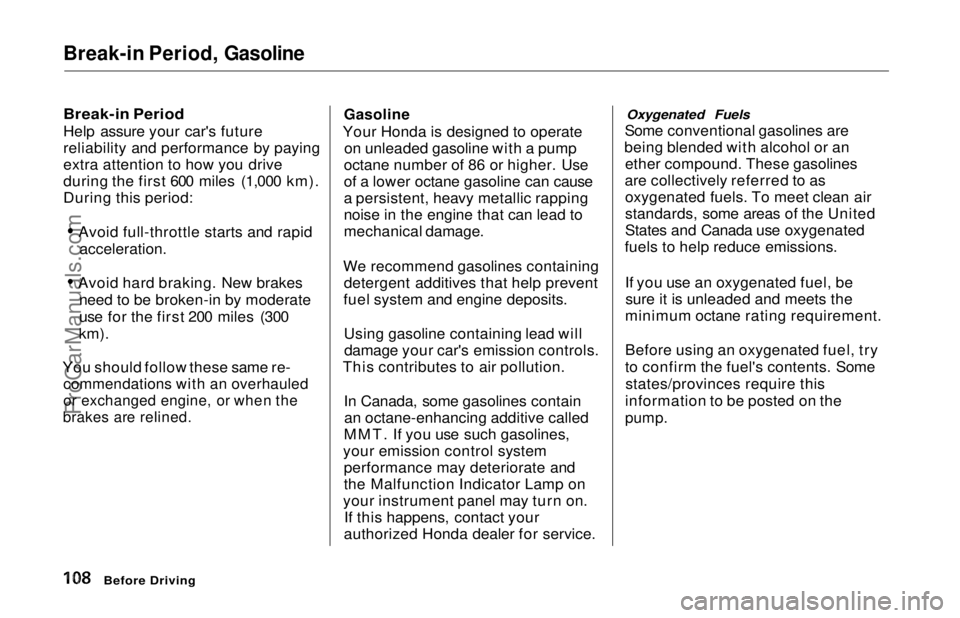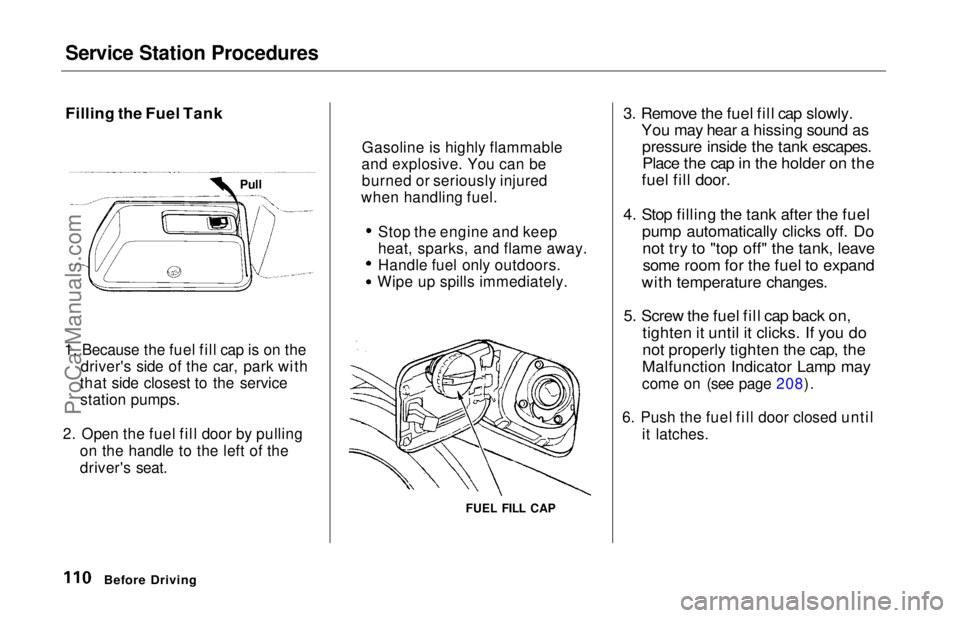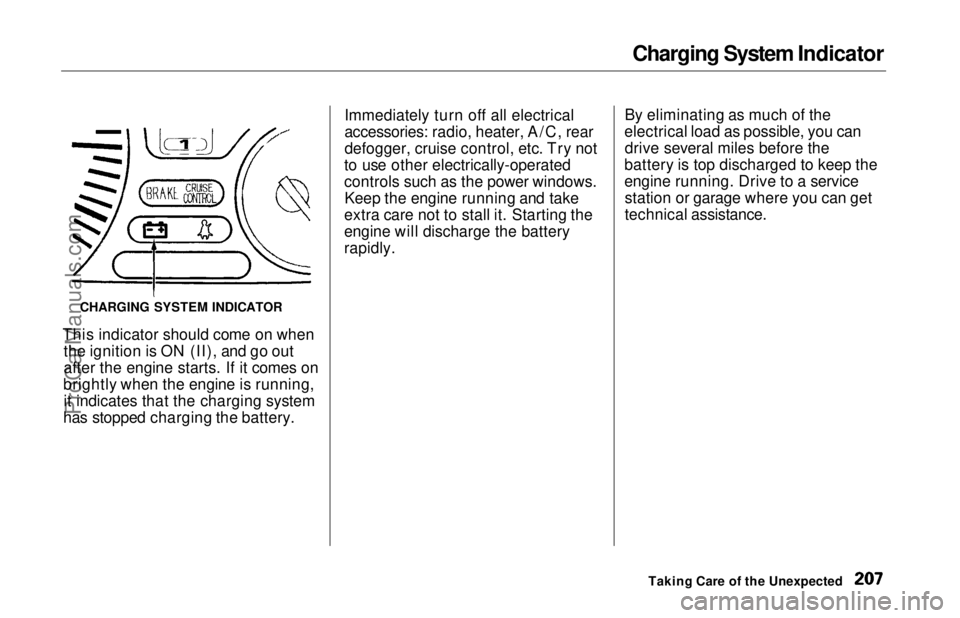1997 HONDA ODYSSEY service indicator
[x] Cancel search: service indicatorPage 4 of 241

Driver and Passenger Safety
This section gives you important
information about occupant protec-
tion. It shows how to use seat belts
properly. It explains the Supple-
mental Restraint System. And it
gives useful information about how
to protect infants and children in
your car.
Your Occupant Protection System.. 4
The Seat Belt System
and How It Works...................... 5
Why Wear Seat Belts.................... 5
Important Safety Reminders........ 5
Seat Belt System Components..... 6
Lap/Shoulder Belt......................... 6
Lap Belt........................................... 7
Wearing Seat Belts Properly........ 7
Wearing a Lap/Shoulder Belt...... 7
Wearing the Lap Belt.................... 9
Advice for Pregnant Women...... 10
Seat Belt Maintenance................ 11
Supplemental Restraint System..... 12
SRS Components......................... 12
What Happens In a Crash........... 12
Important Facts About
Airbags...................................... 13
How the Driver's Airbag Works........................................ 14
How the Passenger's Airbag Works........................................ 15
How the SRS Indicator Light Works........................................ 16
System Service............................. 16
System Service Precautions....... 17
Additional Safety Information........ 18
Seat-back Position........................ 18
Head Restraint Position.............. 18
Door Locks................................... 19 Storing Cargo Safely................... 19
Driving with Pets......................... 19
Child Safety...................................... 20 Where Should Children Sit?....... 20Important Safety Reminders...... 21
General Guidelines for Restraining Children Under 40 Ibs (18 kg) ............... 22
Restraining
an Infant Who WeighsLess Than 20 Ibs (9 kg).......... 22
Restraining
a Child Who Weighs Between 20 and 40 Ibs (9 and 18 kg)..... 23
Restraining a Child Who Weighs Over 40 Ibs (18 kg).................. 24
Securing a Child Seat with a Lap/Shoulder Belt................... 25
Using Child Restraints with Tethers............................. 26
Storing a Child Seat..................... 27
Alcohol and Drugs........................... 28 Carbon Monoxide Hazard.............. 29
Safety Labels.................................... 30
Driver and Passenger SafetyProCarManuals.comMain Menu s t
Page 17 of 241

Supplemental Restraint System
The passenger's airbag is stored near the top of the dashboard, under
a lid marked SRS. Do not place any
objects on top of this lid. If the airbag
inflates, those objects can be
propelled inside the car and possibly
hurt someone. How the SRS Indicator
Light Works
The purpose of the SRS light on your instrument panel is to alert you to a
potential problem with your supple- mental restraint system.
Have the system checked if: The light does not come on when
you turn the ignition ON (II). The light stays on after the engine
starts. The light comes on or flashes
while you are driving.
If you see any of these indications,
the airbag may not work when needed in an accident. Take the car
to your dealer promptly for diagnosis and service.
System Service
Your supplemental restraint system is virtually maintenance-free. Theonly scheduled maintenance is an
inspection of the system by the
dealer when the car is ten years old.
For your convenience, the car's
production date is on a label on thedriver's doorjamb.
If either of the following happens,
you must have an authorized Honda dealer service the system. There are
no parts you can safely service. If your airbags ever inflate, the
airbags and control unit must be
replaced. Do not try to remove or discard the airbags yourself. This
must be done by a Honda dealer.
Driver and Passenger Safety
S R S
ProCarManuals.comMain Menu Table of Contents s t
Page 18 of 241

Supplemental Restraint System
If the SRS indicator light alerts
you to a problem, have the supplemental restraint system
inspected as soon as possible. If
you ignore this indication, the airbags might not inflate when you
need them. System Service Precautions
Do not modify your steering wheel
or any other part of the supplemental
restraint system. Modifications could
make the system ineffective.
Do not tamper with the system's
components or wiring. This could cause the airbags to inflate inadver-
tently, possibly injuring someone
very seriously.
Tell anyone who works on your car that you have a supplemental
restraint system. Failure to follow
the procedures and precautions in
the official Honda service manualcould result in personal injury ordamage to the system. Scrapping an entire car that has
uninflated airbags can be dangerous.
Get assistance from a Honda dealer
if your car must be scrapped.
If you sell your car, please be sure to
tell the new owner that the car has a supplemental restraint system. Alert
them to the information and precau- tions in this part of the owner's
manual.
Driver and Passenger SafetyProCarManuals.comMain Menu Table of Contents s t
Page 108 of 241

Break-in Period, Gasoline
Break-in Period
Help assure your car's future
reliability and performance by paying
extra attention to how you drive
during the first 600 miles (1,000 km).
During this period:
Avoid full-throttle starts and rapidacceleration.
Avoid hard braking. New brakes need to be broken-in by moderate
use for the first 200 miles (300
km).
You should follow these same re-
commendations with an overhauled
or exchanged engine, or when the
brakes are relined.
Gasoline
Your Honda is designed to operate on unleaded gasoline with a pump
octane number of 86 or higher. Use
of a lower octane gasoline can cause
a persistent, heavy metallic rapping
noise in the engine that can lead to
mechanical damage.
We recommend gasolines containing detergent additives that help prevent
fuel system and engine deposits.
Using gasoline containing lead willdamage your car's emission controls.
This contributes to air pollution.
In Canada, some gasolines containan octane-enhancing additive called
MMT. If you use such gasolines,
your emission control system performance may deteriorate and
the Malfunction Indicator Lamp on
your instrument panel may turn on. If this happens, contact your
authorized Honda dealer for service. Oxygenated Fuels
Some conventional gasolines are
being blended with alcohol or an ether compound. These gasolines
are collectively referred to as oxygenated fuels. To meet clean air
standards, some areas of the United
States and Canada use oxygenated
fuels to help reduce emissions.
If you use an oxygenated fuel, besure it is unleaded and meets the
minimum octane rating requirement.
Before using an oxygenated fuel, try
to confirm the fuel's contents. Some
states/provinces require this
information to be posted on the
pump.
Before DrivingProCarManuals.comMain Menu Table of Contents s t
Page 110 of 241

Service Station Procedures
Filling the Fuel Tank
1. Because the fuel fill cap is on the driver's side of the car, park with
that side closest to the service station pumps.
2. Open the fuel fill door by pulling on the handle to the left of the
driver's seat.
3. Remove the fuel fill cap slowly.
You may hear a hissing sound aspressure inside the tank escapes.Place the cap in the holder on the
fuel fill door.
4. Stop filling the tank after the fuel pump automatically clicks off. Donot try to "top off" the tank, leavesome room for the fuel to expand
with temperature changes.
5. Screw the fuel fill cap back on, tighten it until it clicks. If you do
not properly tighten the cap, the
Malfunction Indicator Lamp may
come on (see page 208).
6. Push the fuel fill door closed until it latches.
Before Driving
Pull
FUEL FILL CAP
Gasoline is highly flammable
and explosive. You can be burned or seriously injured
when handling fuel. Stop the engine and keep
heat, sparks, and flame away.
Handle fuel only outdoors.
Wipe up spills immediately.ProCarManuals.comMain Menu Table of Contents s t
Page 205 of 241

Charging System Indicator
This indicator should come on when the ignition is ON (II), and go out
after the engine starts. If it comes on
brightly when the engine is running, it indicates that the charging system
has stopped charging the battery. Immediately turn off all electrical
accessories: radio, heater, A/C, rear
defogger, cruise control, etc. Try not
to use other electrically-operated
controls such as the power windows. Keep the engine running and take
extra care not to stall it. Starting the
engine will discharge the battery
rapidly. By eliminating as much of the
electrical load as possible, you can drive several miles before the
battery is top discharged to keep the
engine running. Drive to a service station or garage where you can get
technical assistance.
Taking Care of the Unexpected
CHARGING SYSTEM INDICATORProCarManuals.comMain Menu Table of Contents s t
Page 239 of 241

Index
Seats
Folding the Third Seats.............. 60
Head Restraints........................... 56
Passenger Seating....................... 54
Reclining the Second Seat.......... 59
Removing the Second Seats....... 57
Third Seat Access........................ 56
Serial Number................................ 218
Service Intervals*.......................... 142
Service Manual.............................. 235
Service Station Procedures .......... 110
Setting the Clock............................. 66
Shifting the Automatic
Transmission.............................. 120
Shift Lever Position Indicator...... 120
Shift Lever Positions..................... 120
Side Marker Lights, Bulb
Replacement in.......................... 180
Signaling Turns................................ 41
Snow Tires...................................... 176
Solvent-type Cleaners.................... 186
Sound System................................... 83
Spare Tire
Inflating....................................... 194
Specifications............................. 221
Spark Plugs, Replacing................. 162 Specifications Charts..................... 220
Speed Control................................... 46
Speedometer.................................... 37
SRS Indicator.............................. 16, 34
START (Ignition Key Position)..... 50
Starting the Engine........................ 119 In Cold Weather at HighAltitude................................... 119
With a Dead Battery................. 202
Steam Coming from Engine......... 204
Steering Wheel
Adjustment................................... 44
Anti-theft Column Lock.............. 49
Stereo Sound System...................... 83
Storing Your Car............................ 184
Sunroof.............................................. 63
Closing Manually....................... 209
Operation...................................... 63
Supplemental Restraint System Service Precautions..................... 17
Servicing....................................... 16
SRS Indicator.......................... 16, 34
System Components.................... 12
Synthetic Oil................................... 149 Tailgate............................................. 52
Taillights, Changing Bulbs in....... 181
Taking Care of the Unexpected .. 193
Tape Player................................. 87, 99
Technical Descriptions Emission Control Systems........ 225
Three Way Catalytic Converter................................ 227
Tire Information........................ 222
Temperature Gauge........................ 38
Tether Attachment Points.............. 26 Three Way Catalytic Converter... 227
Time, Setting the............................. 66
Timing Belt..................................... 170
Tire Chains..................................... 176
Tire, How to Change a Flat.......... 195
Tires................................................ 171 Air Pressure............................... 171
Checking Wear.......................... 173
Compact Spare........................... 194
DOT Tire Quality Grading....... 223
Inflation....................................... 171
CONTINUEDProCarManuals.comMain Menu s t